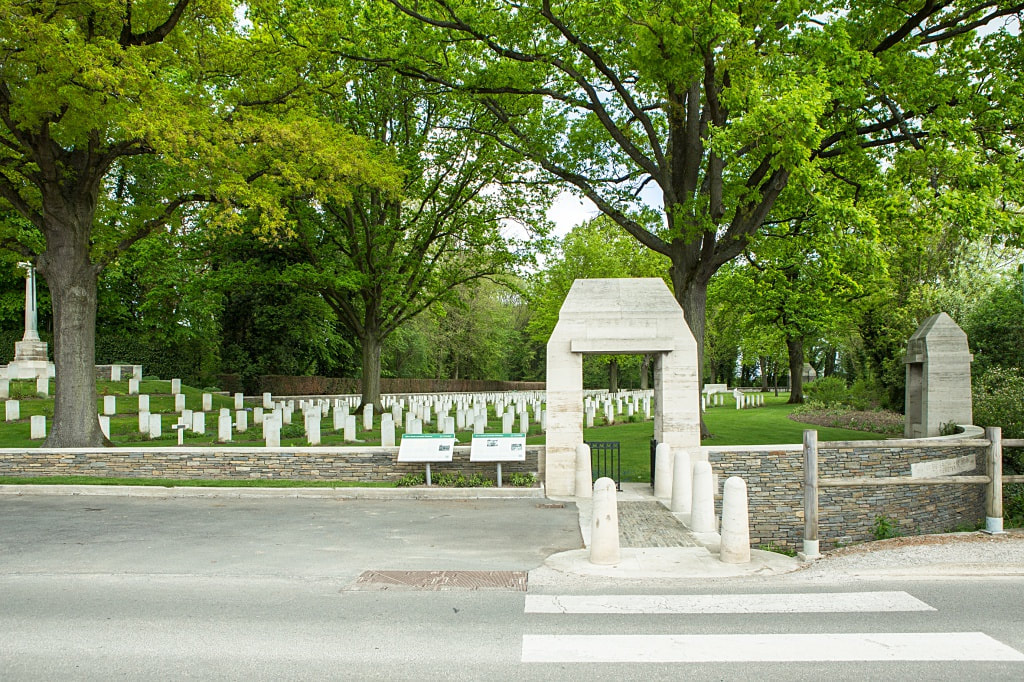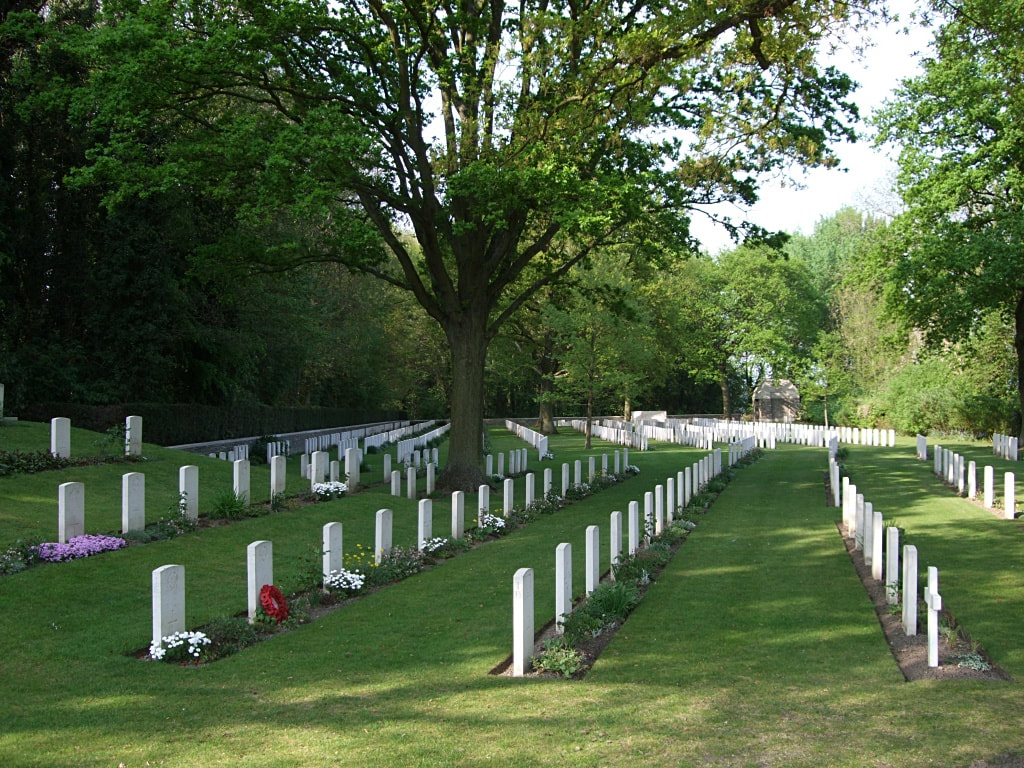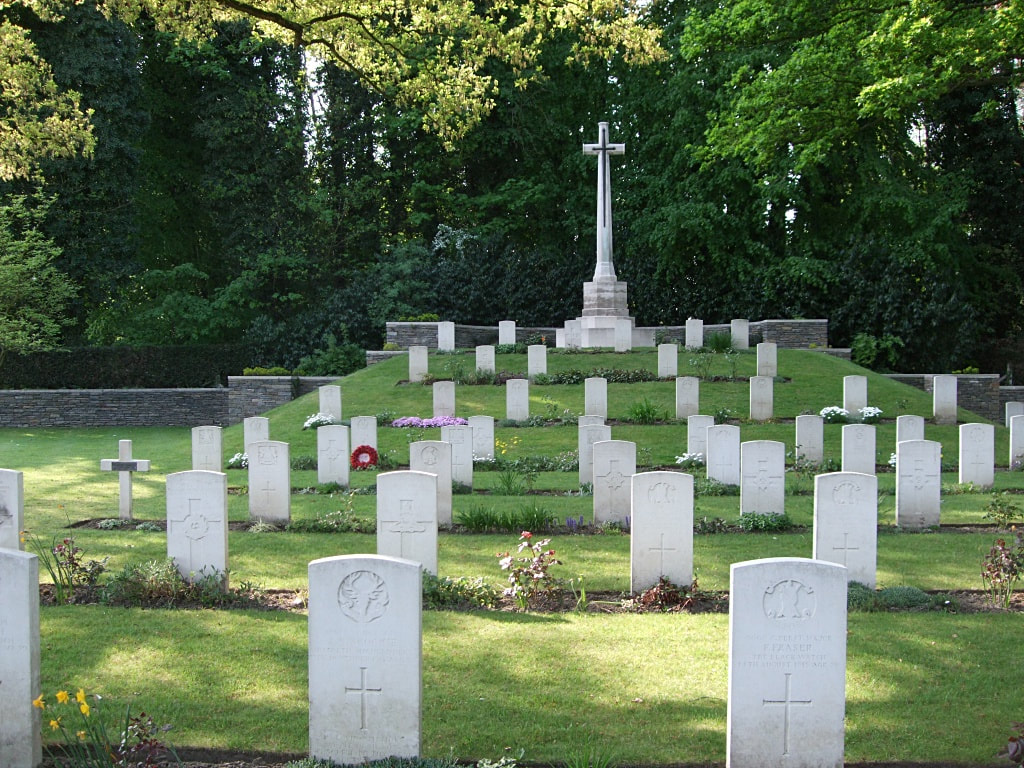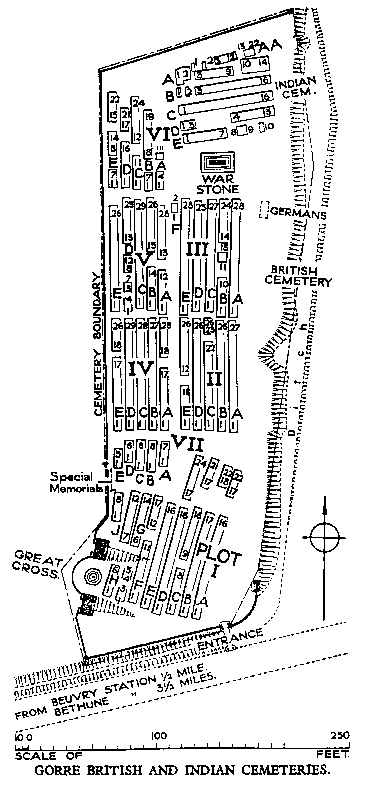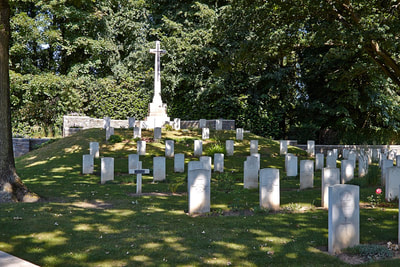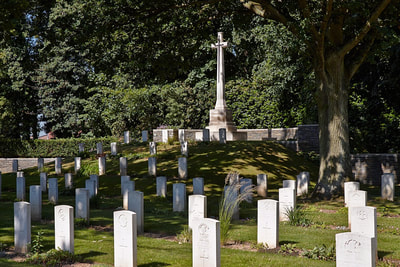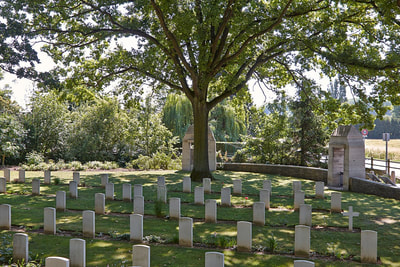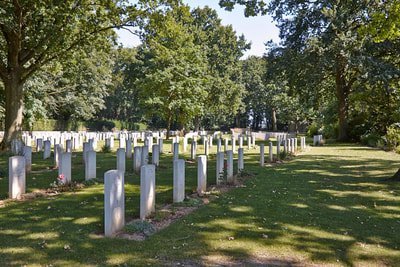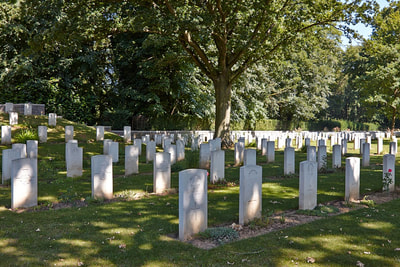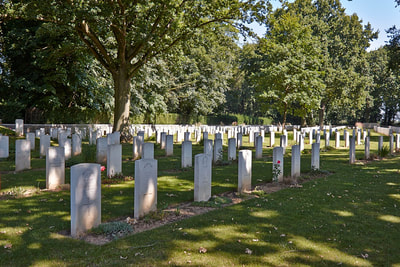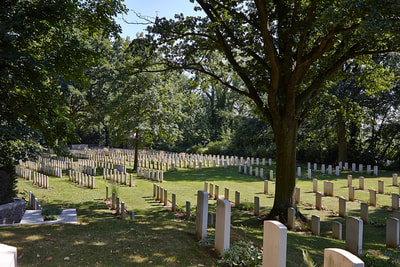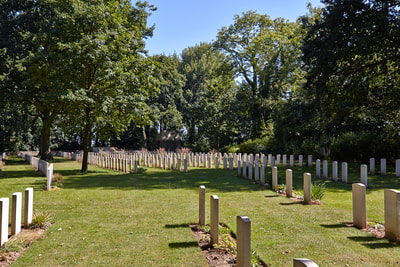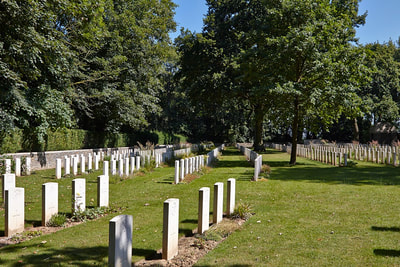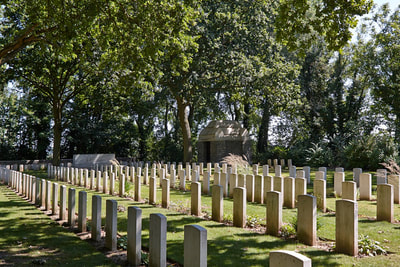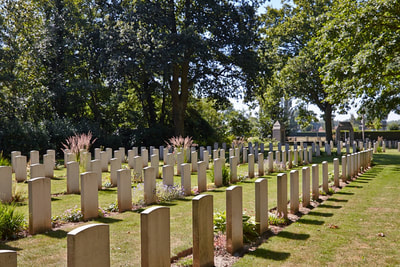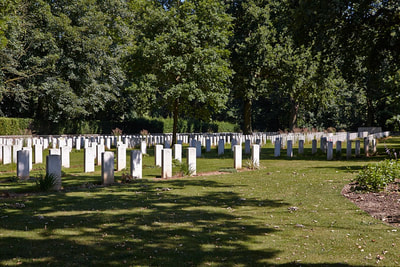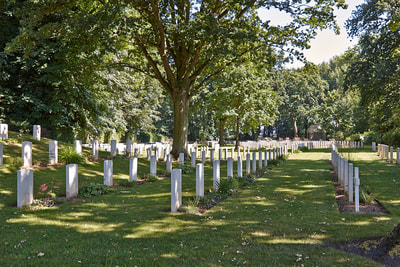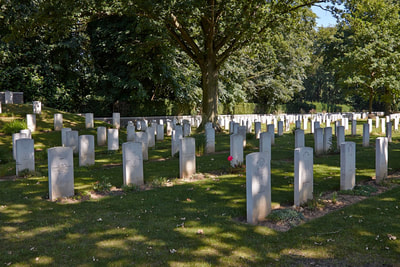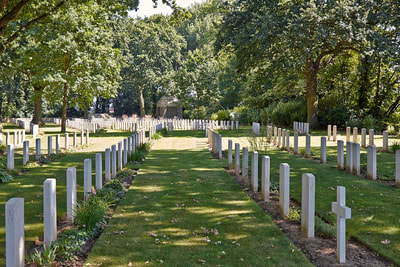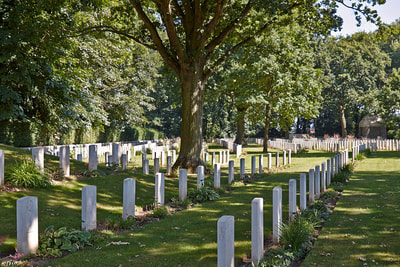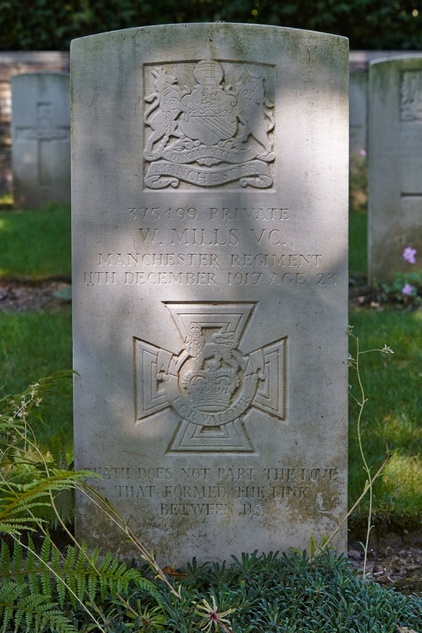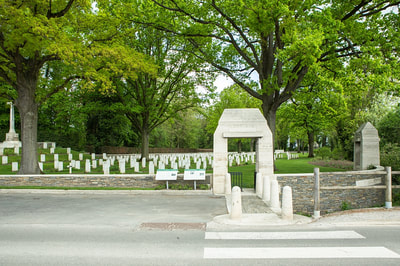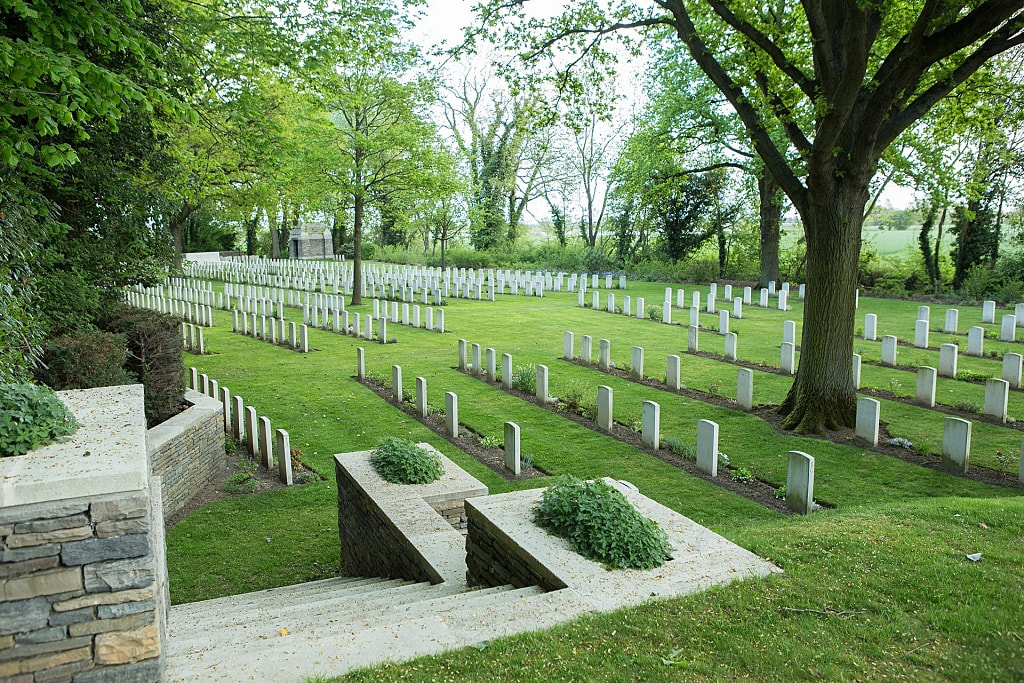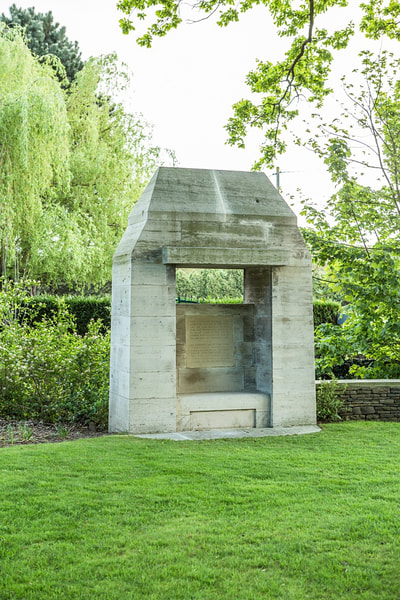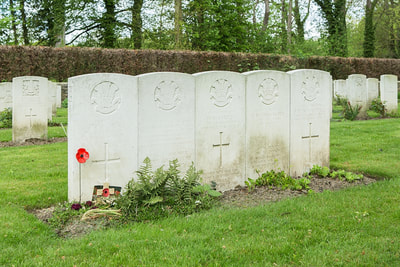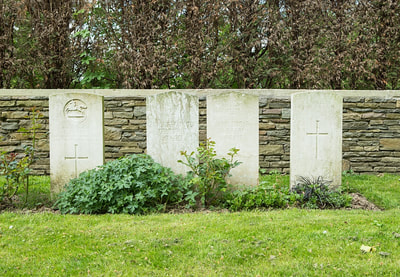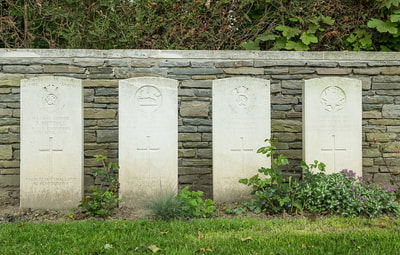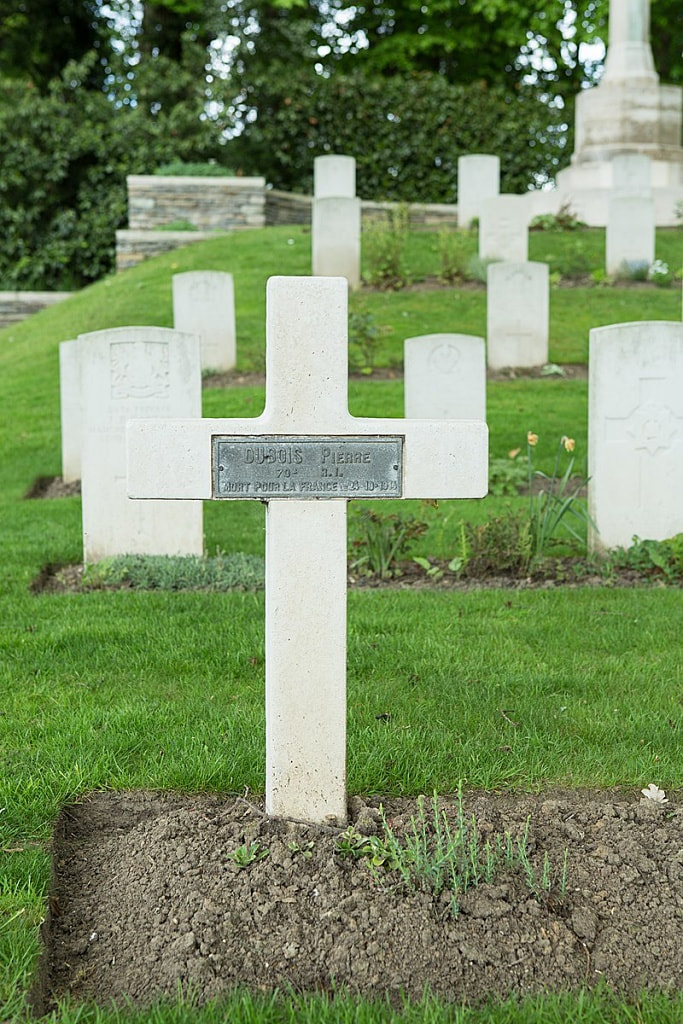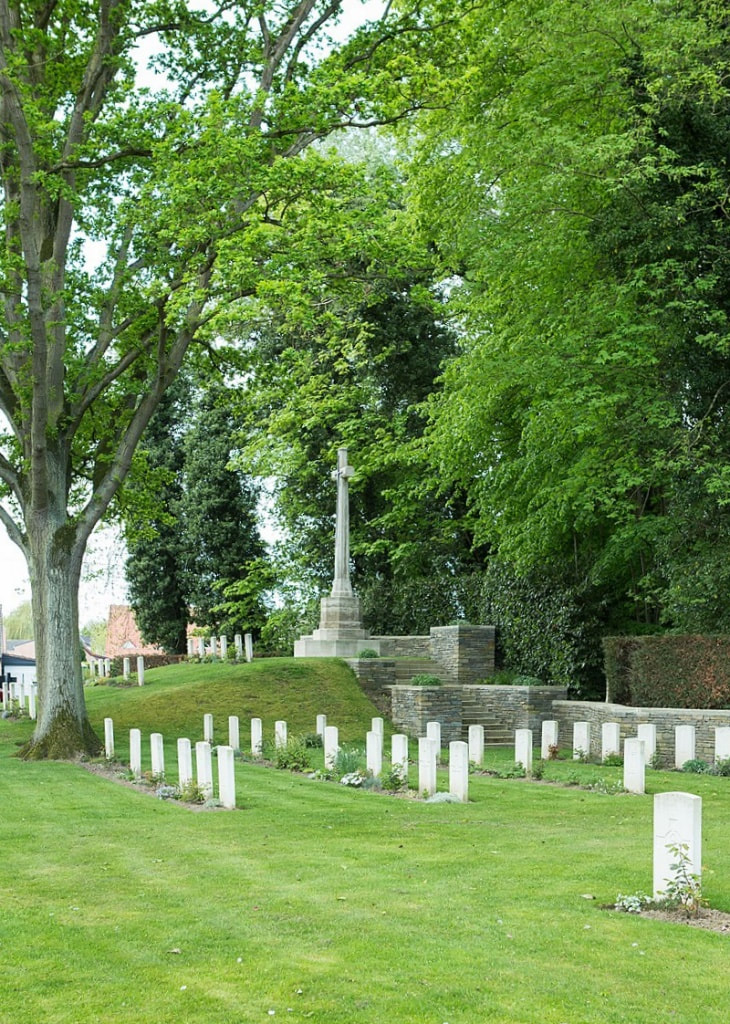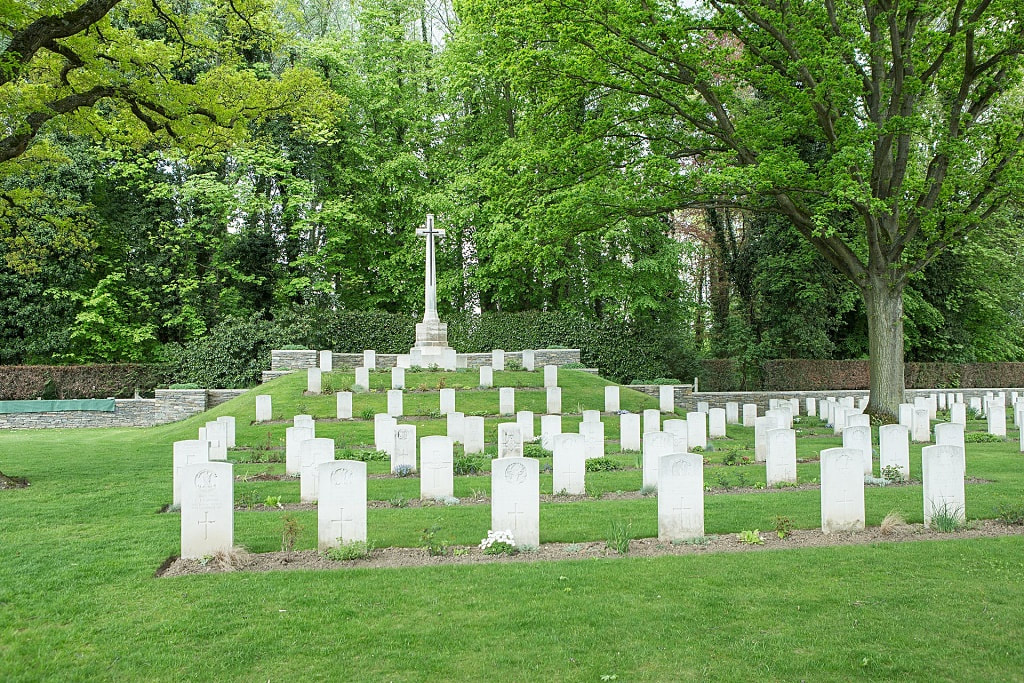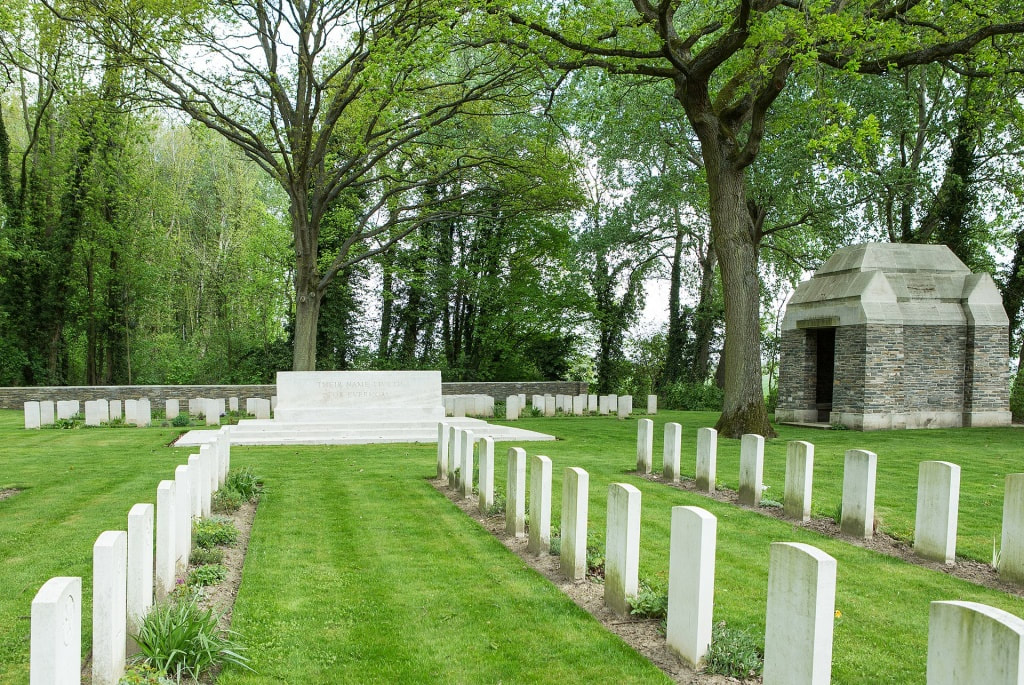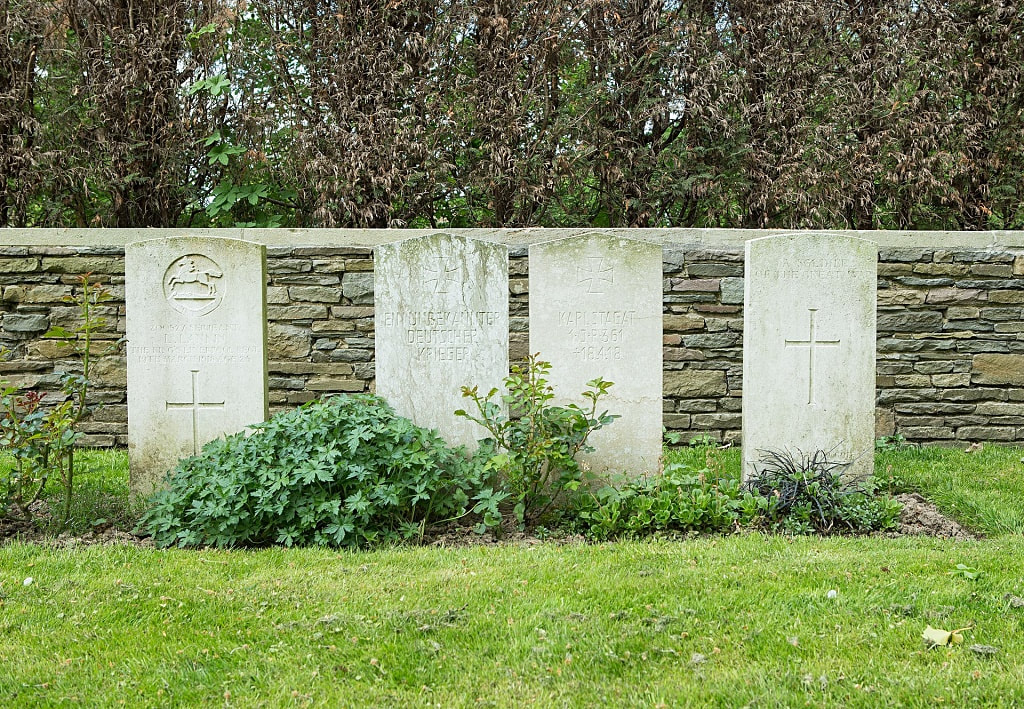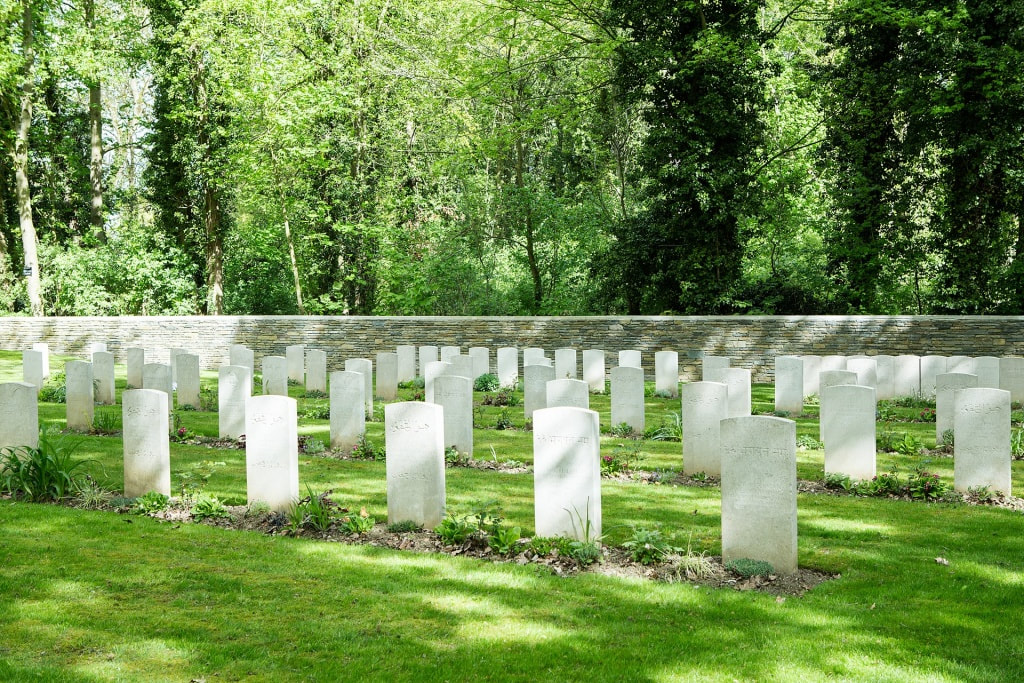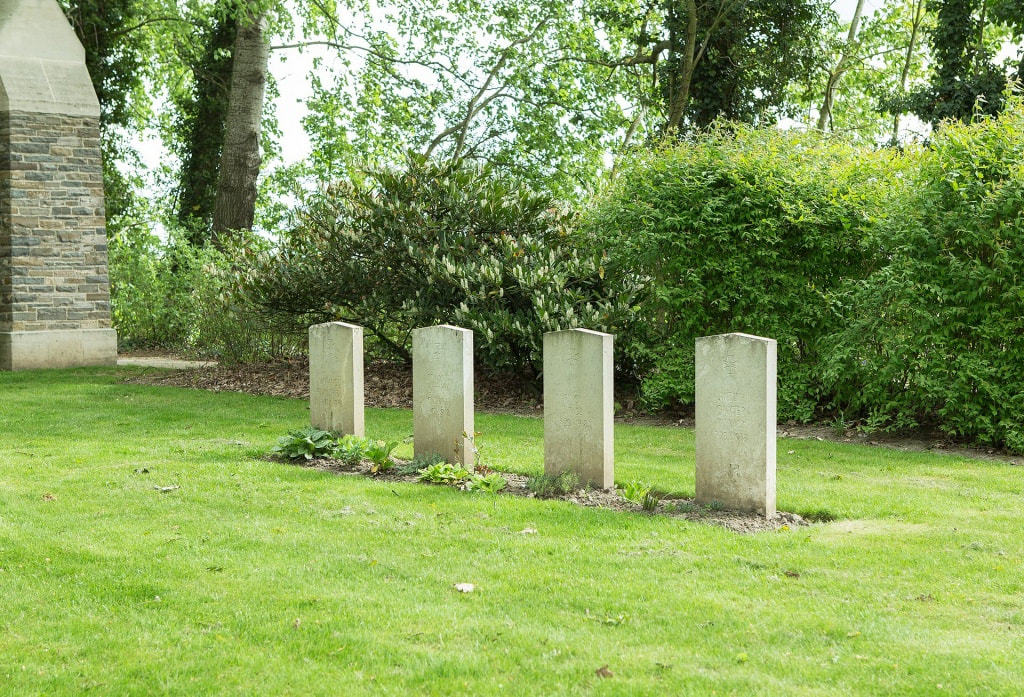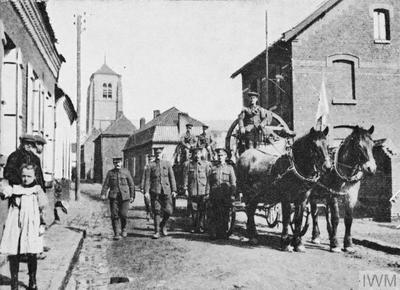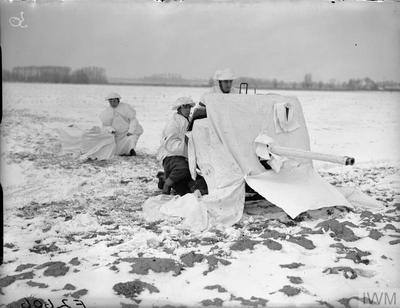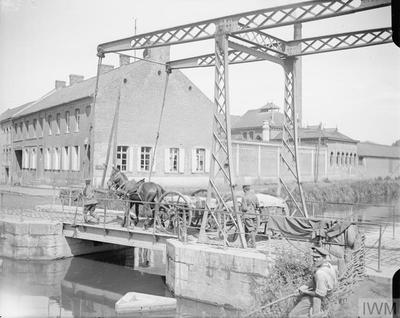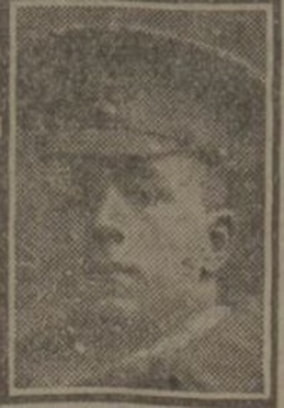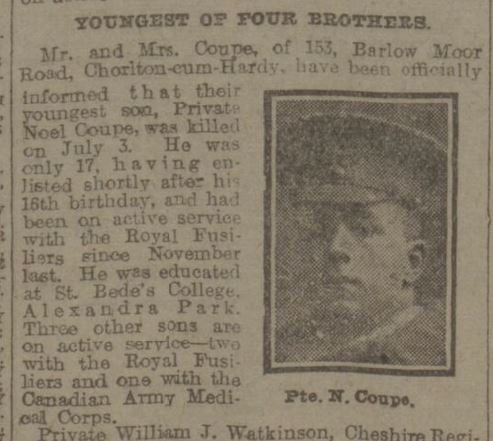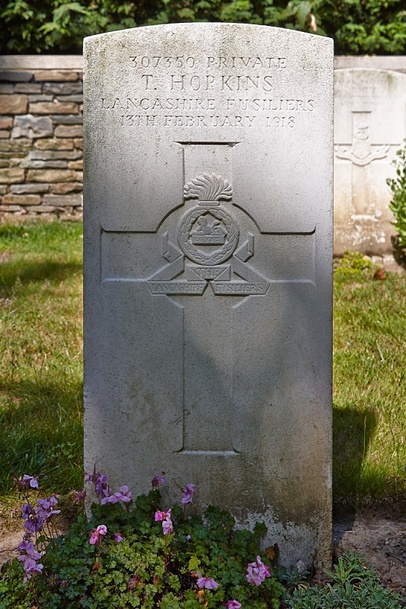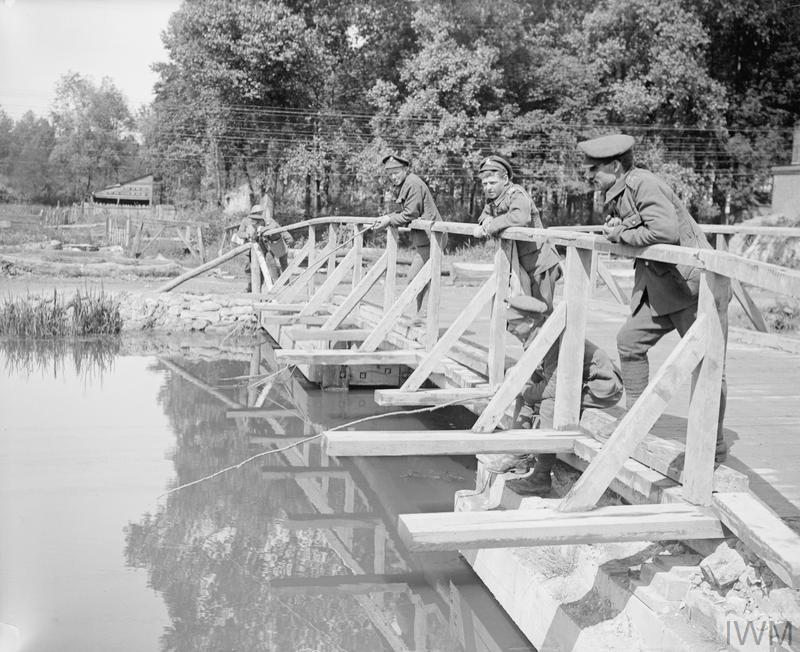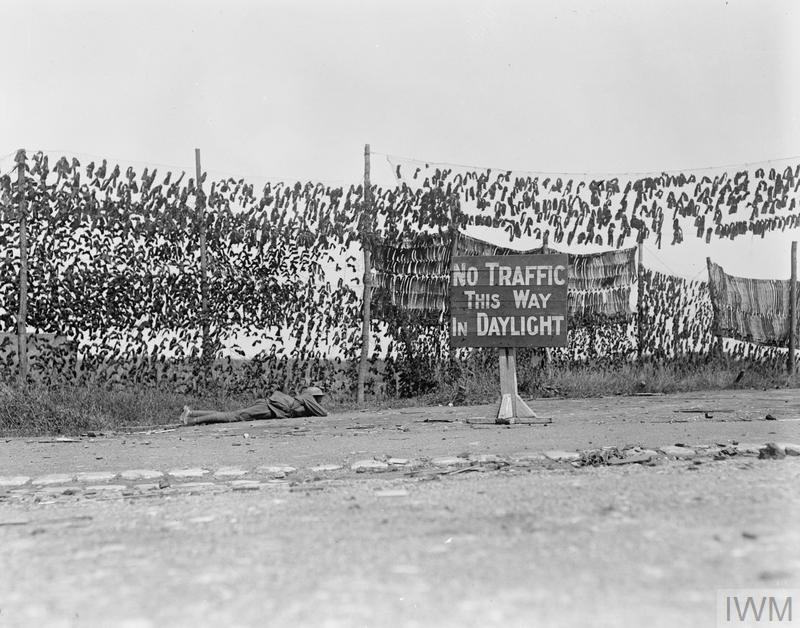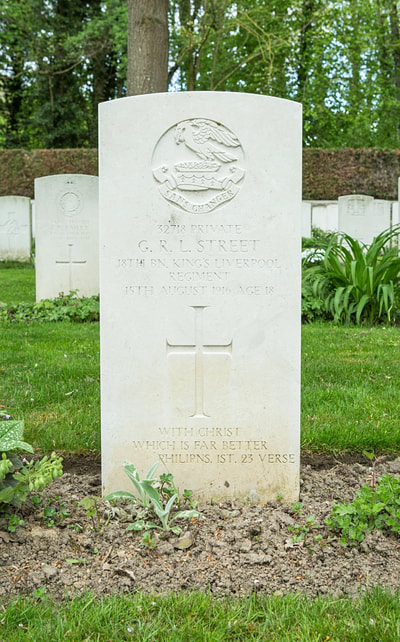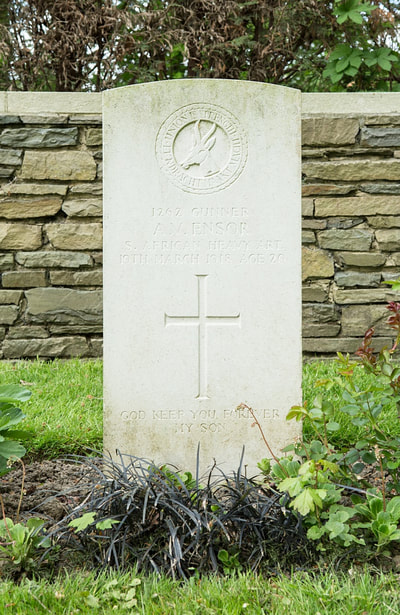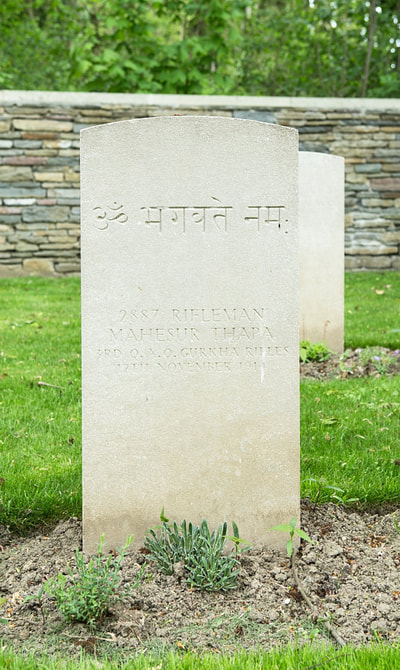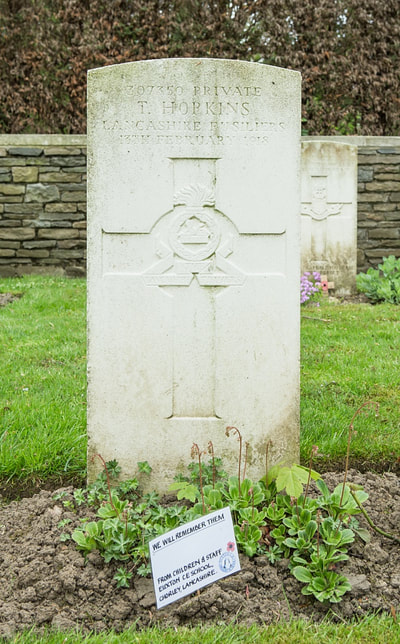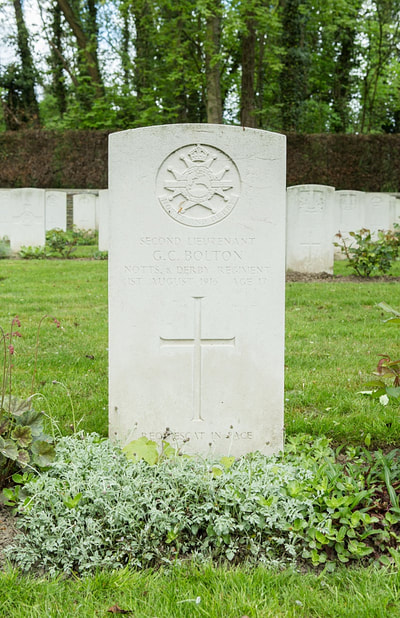GORRE BRITISH AND INDIAN CEMETERY
Pas De Calais
France
GPS Coordinates Latitude: 50.53975 Longitude: 2.69974
Location Information
Gorre is a hamlet 2.5 kilometres north of Beuvry, and 4 kilometres east of Bethune.
Leave Beuvry on the D72, crossing the railway and then the Canal d'Aire on the way. The Cemetery is 150 metres from the church in Gorre, to the left of the D72 (Rue de Festubert).
Historical Information
Gorre British and Indian Cemetery
The chateau at Gorre was occupied early in the war by troops serving with the British Expeditionary Force and the Indian Corps, and the cemeteries, located in the south-east corner of original the chateau grounds, were begun in the autumn of 1914. The Indian section of the cemetery was closed in October 1915, shortly before the Indian infantry divisions left France for redeployment to the Middle East.
Many of those who now lie in plots V and VI of the British section of the cemetery were killed during the Battle of Estaires in April 1918. There are now 933 Commonwealth servicemen of the First World War buried or commemorated here. The cemetery, which was designed by Charles Holden, also contains nine war graves of other nationalities, most of them German.
Gorre Chateau during the First World War
For much of the war, the chateau stood approximately four kilometres behind a section of the British front-line that ran northward along the Aubers Ridge from Givenchy-lès-la-Bassée to Festubert. From the end of the Battle of Festubert in May 1915 until the spring of 1918, this was considered a relatively ‘quiet’ sector. The village of Gorre was occasionally bombarded by German artillery during this period, but the chateau remained intact and its rooms were used as an officer’s mess and headquarters for British units stationed in the area. The grounds of the chateau were also the site of several artillery emplacements, a rifle range and an improvised parade ground and football pitch. Throughout 1916 and ’17 British troops could be seen drilling in the fields next to the chateau or unloading supplies from barges on the La Bassée Canal, which runs just south of the village.
The British section of the cemetery was used by infantry and artillery units stationed in the area until April 1918, when the relative quiet of the sector was shattered by the German Spring Offensive and Gorre became a support post close behind the front line during the Battle of Estaire. This battle was one of two massive German assaults on the Commonwealth positions from Ypres to Festubert that became known as the Battle of the Lys. When the battle erupted on 9 April, the 55th (West Lancashire) Division occupied the front-line trenches running north from Givenchy to Richebourg L’Avoué. The Allied positions to their left, around the village of Le Touret, were held by Portuguese units.
After a preliminary artillery bombardment that began on the evening of 7 April the German Sixth Army, spearheaded by storm troops, attacked in force early on the morning of the 9th. Heavy mist enabled the attackers to get very close to the Allied lines before they were observed and Portuguese units suffered heavy casualties and began to retire. Further south, the various formations of the 55th Division were hard pressed from the outset and the front line trenches around Givenchy were the scene of fierce fighting between British and German troops. The divisional brigade holding the northern section of the British line was forced to pull back, but well-organised counter-attacks and determined defence elsewhere enabled the 55th Division to hold its ground for the rest of the battle and prevent a major German breakthrough. Fighting continued in the trenches east of Gorre until 17 April when the German forces finally broke off the attack. In just over a week of fighting almost 3,000 officers and men of the Division had been killed, wounded, or taken prisoner, but the territory over which they had fought remained in Allied hands.
Total Burials: 942.
Identified Casualties: United Kingdom 815, India 80, Germany 6, South Africa 2, Australia 1, France 1. Total 905.
Unidentified Casualties: 37.
The cemetery was designed by Charles Henry Holden & Captain Wilfred Clement Von Berg, MC
Images in this gallery © Geerhard Joos
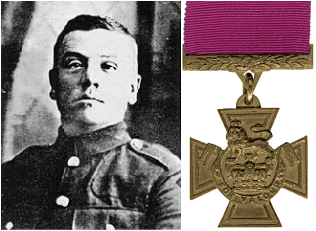
375499 Private
Walter Mills, V. C.
1st/10th Bn. Manchester Regiment
died from gas poisoning 11th February 1917, aged 23.
Plot V. C. 2.
Husband of Mrs E. Mills, of 10 Smith St., Oldham.
Citation:
An extract from "The London Gazette," No. 30523, dated 12th Feb., 1918, records the following:-"For most conspicuous bravery and self-sacrifice. When, after an intense gas attack, a strong enemy patrol endeavoured to rush our posts, the garrisons of which had been overcome, and, though badly gassed himself, he met the attack single-handed and continued to throw bombs until the arrival of reinforcements, and remained at his post until the enemy's attacks had been finally driven off. While being carried away he died from gas poisoning. It was solely due to his exertions, when his only chance of personal safety lay in remaining motionless, that the enemy was defeated and the line retained intact."
Walter Mills, V. C.
1st/10th Bn. Manchester Regiment
died from gas poisoning 11th February 1917, aged 23.
Plot V. C. 2.
Husband of Mrs E. Mills, of 10 Smith St., Oldham.
Citation:
An extract from "The London Gazette," No. 30523, dated 12th Feb., 1918, records the following:-"For most conspicuous bravery and self-sacrifice. When, after an intense gas attack, a strong enemy patrol endeavoured to rush our posts, the garrisons of which had been overcome, and, though badly gassed himself, he met the attack single-handed and continued to throw bombs until the arrival of reinforcements, and remained at his post until the enemy's attacks had been finally driven off. While being carried away he died from gas poisoning. It was solely due to his exertions, when his only chance of personal safety lay in remaining motionless, that the enemy was defeated and the line retained intact."
Images in this gallery Werner Van Caneghem
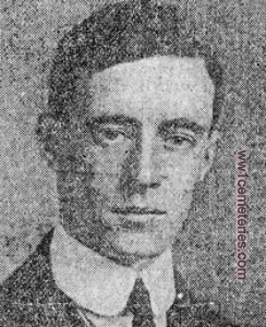
2766 Private
Frederic Train Barr
9th (Glasgow Hdrs.) Bn. Highland Light Infantry
25th February 1915, aged 26.
Plot I. H. 6.
Son of James and Mary Barr. Native of Glasgow.
His headstone bears the inscription; "He Loved Honour More Than He Feared Death."
Frederic Train Barr
9th (Glasgow Hdrs.) Bn. Highland Light Infantry
25th February 1915, aged 26.
Plot I. H. 6.
Son of James and Mary Barr. Native of Glasgow.
His headstone bears the inscription; "He Loved Honour More Than He Feared Death."
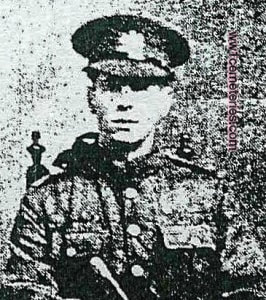
351639 Private
Wilfred Batty
2nd/9th Bn. Manchester Regiment
20th April 1917
Plot IV. A. 7.
Son of Mr. Joseph Batty, of 13, Welbeck St., Ashton-under-Lyne.
Wilfred Batty
2nd/9th Bn. Manchester Regiment
20th April 1917
Plot IV. A. 7.
Son of Mr. Joseph Batty, of 13, Welbeck St., Ashton-under-Lyne.
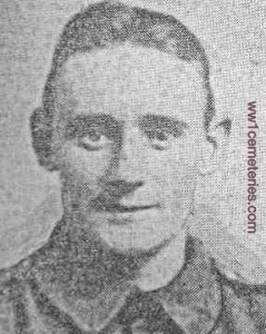
241223 Private
Albert Brown
2nd/5th Bn. East Lancashire Regiment
29th April 1917
Plot IV. A. 25.
Husband of Mrs. S. Brown, of 103, Todmorden Rd., Burnley Wood, Burnley.
Albert Brown
2nd/5th Bn. East Lancashire Regiment
29th April 1917
Plot IV. A. 25.
Husband of Mrs. S. Brown, of 103, Todmorden Rd., Burnley Wood, Burnley.
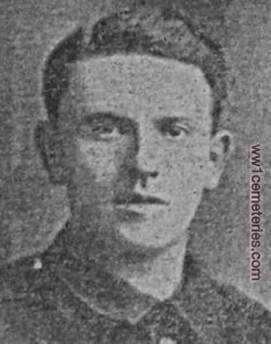
201866 Private
Hesketh Riley Cornthwaite
"A" Coy. 1st/5th Bn, King's Own (Royal Lancaster Regiment)
7th March 1918, aged 25.
Plot V. E. 1.
Son of Hesketh and Jennie Cornthwaite; husband of Agnes Mary Cornthwaite, of 15, Branch Rd., Burnley, Lancs.
His headstone bears the inscription; "God's Will Be Done."
Hesketh Riley Cornthwaite
"A" Coy. 1st/5th Bn, King's Own (Royal Lancaster Regiment)
7th March 1918, aged 25.
Plot V. E. 1.
Son of Hesketh and Jennie Cornthwaite; husband of Agnes Mary Cornthwaite, of 15, Branch Rd., Burnley, Lancs.
His headstone bears the inscription; "God's Will Be Done."
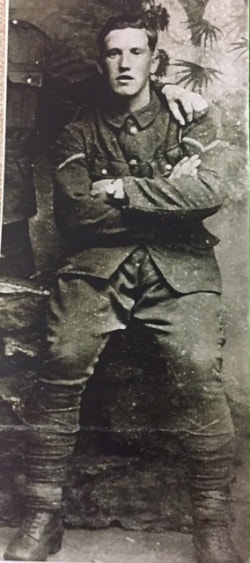
86442 Lance Corporal
Joseph Diskin
176th Tunnelling Company, Royal Engineers
28th January 1916.
Plot I. A. 16.
Son of Mr. W. Diskin, of 52, Warrington Lane, Abram, Nr.Wigan.
Picture and text below courtesy of Ian Mills (Great Nephew).
Joseph had two other brothers that survived the 1st World War. One being my grandfather, Sydney Diskin , the other being Richard Diskin who emigrated to New Zealand. All three brothers signed up at the start of the war and were survived by their sister Rose who was 94 when she died.
Joseph Diskin
176th Tunnelling Company, Royal Engineers
28th January 1916.
Plot I. A. 16.
Son of Mr. W. Diskin, of 52, Warrington Lane, Abram, Nr.Wigan.
Picture and text below courtesy of Ian Mills (Great Nephew).
Joseph had two other brothers that survived the 1st World War. One being my grandfather, Sydney Diskin , the other being Richard Diskin who emigrated to New Zealand. All three brothers signed up at the start of the war and were survived by their sister Rose who was 94 when she died.
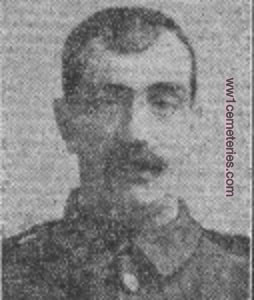
269247 Private
John Feeney
1st/7th Bn. The King's (Liverpool Regiment)
18th March 1918
Plot VI. E. 17.
John Feeney
1st/7th Bn. The King's (Liverpool Regiment)
18th March 1918
Plot VI. E. 17.
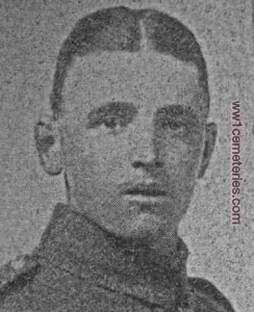
240604 Private
William Harrison
2nd/5th Bn. East Lancashire Regiment
13th April 1917, aged 25.
Plot VII. C. 8.
Son of John and Alice Ann Taylor Harrison, of Argyle St., Burnley; husband of Ethel Greenwood (formerly Harrison), of 128, New Hall St., Burnley.
His headstone bears the following inscription; "To Memory Ever Dear."
William Harrison
2nd/5th Bn. East Lancashire Regiment
13th April 1917, aged 25.
Plot VII. C. 8.
Son of John and Alice Ann Taylor Harrison, of Argyle St., Burnley; husband of Ethel Greenwood (formerly Harrison), of 128, New Hall St., Burnley.
His headstone bears the following inscription; "To Memory Ever Dear."
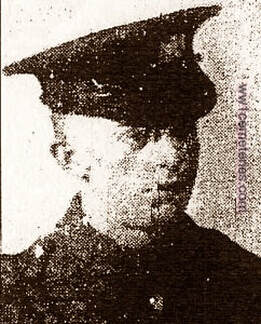
352870 Private
Harold Hodgin
2nd/9th Bn. Manchester Regiment
13th June 1917, aged 21.
Plot IV. D. 14.
Son of James and Mary Hodgin, of 97, Union St., Ashton-under-Lyne, Lancs.
Harold Hodgin
2nd/9th Bn. Manchester Regiment
13th June 1917, aged 21.
Plot IV. D. 14.
Son of James and Mary Hodgin, of 97, Union St., Ashton-under-Lyne, Lancs.
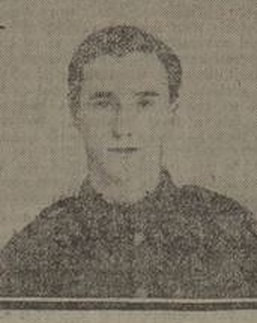
1463 Private
Thomas McLean
4th Bn. Black Watch (Royal Highlanders)
16th July 1916, aged 19.
Plot II. B. 9.
Son of Thomas and Mary McLean, of 5, William Lane, Dundee.
Thomas McLean
4th Bn. Black Watch (Royal Highlanders)
16th July 1916, aged 19.
Plot II. B. 9.
Son of Thomas and Mary McLean, of 5, William Lane, Dundee.
Shot at Dawn
307350 Private Thomas Hopkins, 1st/8th Bn. Lancashire Fusiliers, executed for leaving his post 13th February 1918, aged 26. Plot V. D. 13. Husband of M. A. Hopkins, of 6, Vine St., Birkenhead.
He joined up on 4 Sept 1916; & on 1 Sept 1917 was serving in the trenches for the first time when at 0200 hours the gas alarm was given. When the ‘Gas Clear’ call was given, Hopkins was missing, though he had left behind all his equipment. He was not seen again until 9 or 10 Sept — when he would have been arrested.
Hopkins escaped from custody during the night of 18-19 Sept; was back in custody on 10 Oct at Coxyde; escaped again, making off into the dunes; & at some stage thereafter recaptured.
He was not tried till 3 Dec 1917, the delay being due to necessary consultation with Army lawyers — which resulted in a charge of quitting his post (which was accompanied by 2 charges of escaping). In relation to the first charge, Hopkins said: ‘I had been lying about & the weather was very cold. I went down a road into a town. I had no pay, & had been handcuffed for 6-7 months, no friends in the regiment’.
After conviction, it emerged that Hopkins had committed several minor (military) offences in the UK, & that at the time that he was sent to France, he was serving a sentence of 112 days’ detention imposed for attempting to desert.
The court had been concerned about his mental state, & suggested further medical examination. Hence he was seen at Wimereux by a specialist— who found him fit for service, sane, & of below average intelligence; & further labelled him a criminal degenerate. Enquiries in England revealed a series of convictions for theft, & 32 summary convictions for vagrancy, drunkenness & assault on the police.
Thereafter, he was considered ‘a very bad character’ who had deliberately committed a very serious offence; & ‘probably useless as a soldier’. Sentence was confirmed on 4 Feb 1918, Hopkins being brought from hospital at Wimereux for his execution 9 days later. (Corns, pp. 145-148)
307350 Private Thomas Hopkins, 1st/8th Bn. Lancashire Fusiliers, executed for leaving his post 13th February 1918, aged 26. Plot V. D. 13. Husband of M. A. Hopkins, of 6, Vine St., Birkenhead.
He joined up on 4 Sept 1916; & on 1 Sept 1917 was serving in the trenches for the first time when at 0200 hours the gas alarm was given. When the ‘Gas Clear’ call was given, Hopkins was missing, though he had left behind all his equipment. He was not seen again until 9 or 10 Sept — when he would have been arrested.
Hopkins escaped from custody during the night of 18-19 Sept; was back in custody on 10 Oct at Coxyde; escaped again, making off into the dunes; & at some stage thereafter recaptured.
He was not tried till 3 Dec 1917, the delay being due to necessary consultation with Army lawyers — which resulted in a charge of quitting his post (which was accompanied by 2 charges of escaping). In relation to the first charge, Hopkins said: ‘I had been lying about & the weather was very cold. I went down a road into a town. I had no pay, & had been handcuffed for 6-7 months, no friends in the regiment’.
After conviction, it emerged that Hopkins had committed several minor (military) offences in the UK, & that at the time that he was sent to France, he was serving a sentence of 112 days’ detention imposed for attempting to desert.
The court had been concerned about his mental state, & suggested further medical examination. Hence he was seen at Wimereux by a specialist— who found him fit for service, sane, & of below average intelligence; & further labelled him a criminal degenerate. Enquiries in England revealed a series of convictions for theft, & 32 summary convictions for vagrancy, drunkenness & assault on the police.
Thereafter, he was considered ‘a very bad character’ who had deliberately committed a very serious offence; & ‘probably useless as a soldier’. Sentence was confirmed on 4 Feb 1918, Hopkins being brought from hospital at Wimereux for his execution 9 days later. (Corns, pp. 145-148)
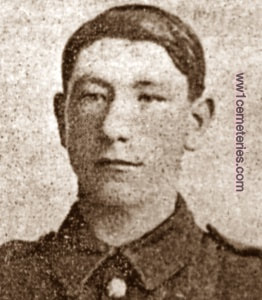
266985 Private
John Francis Monaghan
1st/7th Bn. The King's (Liverpool Regiment)
24th February 1918, aged 20.
Plot V. D. 20.
Son of Michael Lawrence and Margaret Anne Monaghan, of 14, Chaucer St., Bootle, Liverpool.
John Francis Monaghan
1st/7th Bn. The King's (Liverpool Regiment)
24th February 1918, aged 20.
Plot V. D. 20.
Son of Michael Lawrence and Margaret Anne Monaghan, of 14, Chaucer St., Bootle, Liverpool.
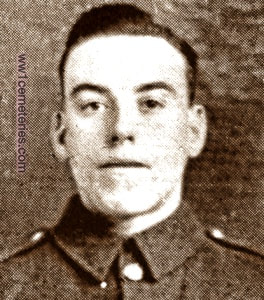
28443 Private
Wilfred Robbins
1st Bn. Cheshire Regiment
24th December 1916
Plot III. D. 19.
Son of Mrs. H. Robbins, of 81, Newgate St., Worksop, Notts.
Wilfred Robbins
1st Bn. Cheshire Regiment
24th December 1916
Plot III. D. 19.
Son of Mrs. H. Robbins, of 81, Newgate St., Worksop, Notts.
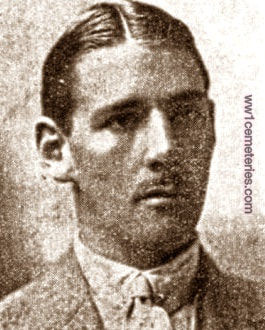
Lieutenant
Gordon Sanderson
Machine Gun Coy, 2nd Bn.2nd King Edward's Own Gurkha Rifles (The Sirmoor Rifles)
13th October 1915, aged 28.
Plot I. E. 11.
Son of William Sanderson, of Field House, Settle, Yorks; husband of Agnes R. Sanderson, of 2, Mentone Gardens, Edinburgh. Public Works Dept, Egypt, and the Archaeological Survey of India.
His headstone bears the following inscription; "He Passed Over And The Trumpets Sounded For Him On The Other Side."
Gordon Sanderson
Machine Gun Coy, 2nd Bn.2nd King Edward's Own Gurkha Rifles (The Sirmoor Rifles)
13th October 1915, aged 28.
Plot I. E. 11.
Son of William Sanderson, of Field House, Settle, Yorks; husband of Agnes R. Sanderson, of 2, Mentone Gardens, Edinburgh. Public Works Dept, Egypt, and the Archaeological Survey of India.
His headstone bears the following inscription; "He Passed Over And The Trumpets Sounded For Him On The Other Side."
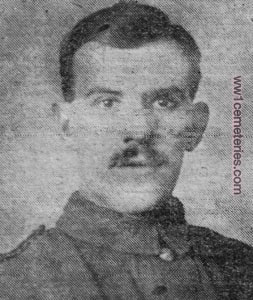
27582 Serjeant
Charles William Smith
17th Bn. Sherwood Foresters (Notts and Derby Regiment)
1st August 1916, aged 22.
Plot II. E. 9.
Son of Edward and Agnes Smith, of Church St., Barrow-on-Soar, Loughborough.
Charles William Smith
17th Bn. Sherwood Foresters (Notts and Derby Regiment)
1st August 1916, aged 22.
Plot II. E. 9.
Son of Edward and Agnes Smith, of Church St., Barrow-on-Soar, Loughborough.
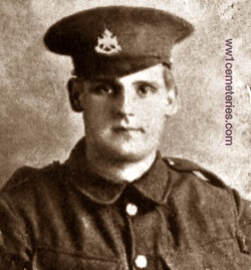
14819 Private
Thomas Storer
17th Bn. Sherwood Foresters (Notts and Derby Regiment)
3rd August 1916, aged 20.
Plot II. E. 22.
Son of Henry and Rose Hannah Storer, of 16, Manvers St., Worksop, Notts.
Thomas Storer
17th Bn. Sherwood Foresters (Notts and Derby Regiment)
3rd August 1916, aged 20.
Plot II. E. 22.
Son of Henry and Rose Hannah Storer, of 16, Manvers St., Worksop, Notts.

